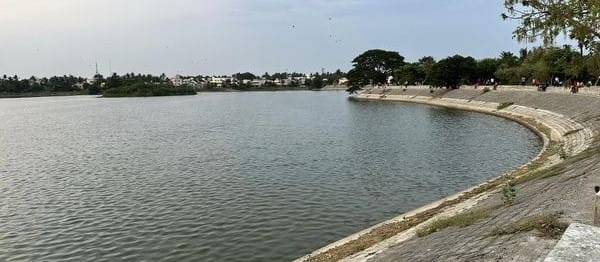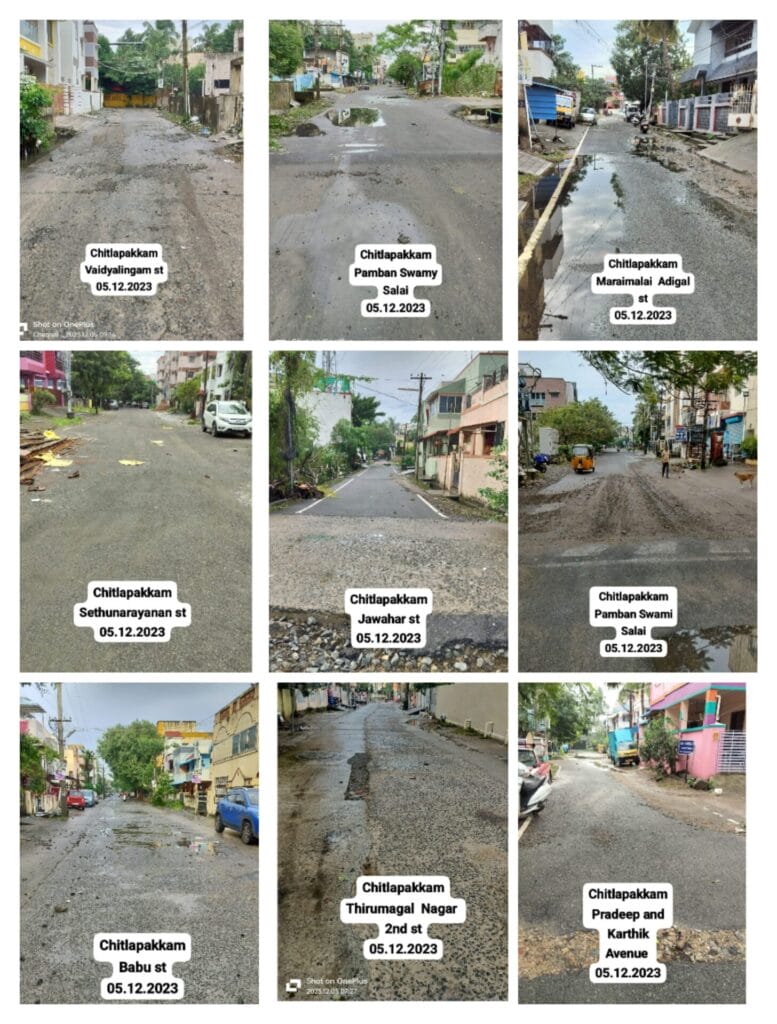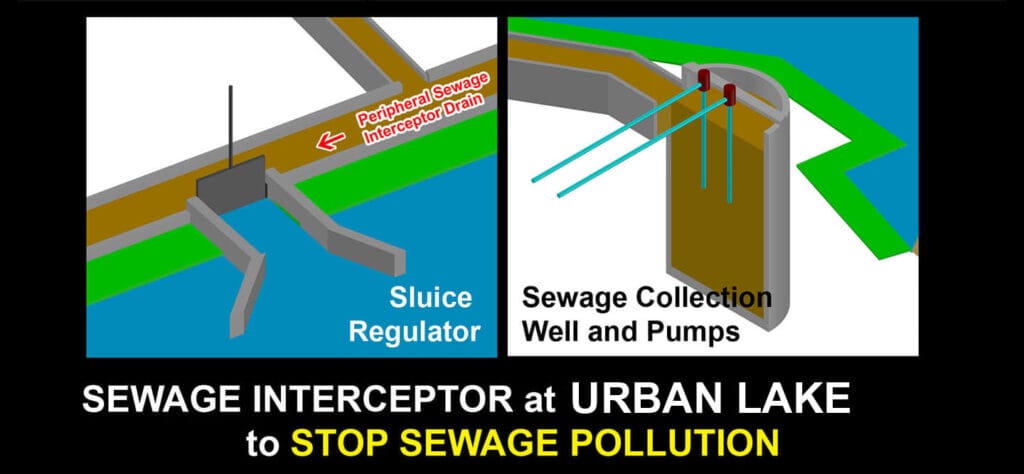Located in the southwestern suburbs of Chennai, the neighbourhood of Chitlapakkam had been prone to flooding only five years ago. About 20 centimetres of rain would cause severe inundation of houses and it was under the threat of sheet flooding of more than five feet of water, which would remain stagnant for around a week. The dream of making this locality flood-free seemed distant at the time but has now become a reality.
Every monsoon, Chitlapakkam would get inundated as the town is sandwiched between the flood plains of Selaiyur lake and Chitlapakkam lake surplus. As a volunteer of the Chitlapakkam Rising (CR) team and being a civil engineer and GIS consultant, I undertook a detailed study of various aspects — the flood surplus discharge into Selaiyur, Chitlapakkam and Sembakkam lakes; terrain study of Chitlapakkam flood plains, Contour study, and creation of merged revenue maps of Selaiyur, Chitlapakkam and Sembakkam villages to find the actual inlet channels and outlet surplus channels, their location, width, length and the interlink between upstream and downstream lakes.

Read more: How citizens brought the mini-bus back to Chitlapakkam
This study gave us a clear idea of why the locality was flood-prone and how we could address the missing links of surplus channels between Selaiyur and Chitlapakkam lakes, and between Chitlapakkam and Sembakkam lakes. These channels were quite wide at the surplus weir and later became narrow terminating halfway, which led to severe flooding of homes in the area.
The beginning of a solution
The same was put forward by the CR team and 15 RWAs active in that area to the Water Resources Department (WRD) and Chitlapakkam town panchayat, and we also petitioned C Rajendran, former MP and Chitlapakkam resident. In September 2018, the then Chief Minister Edappadi K Palanisamy approved funding of around Rs.17.5 crores (Rs.12 crores from Public Works Department and Rs.5.5 crores from Chitlapakkam town panchayat) to construct an underground ‘macro cut and cover’ drain below the roads running along the residential areas of Chitlapakkam to mitigate flooding in that area. This would be the first of its kind in Chennai.
The first macro cut and cover drain for a length of around 1440 metres was constructed in the year 2019 by the local panchayat and WRD to address the flooding issue near Selaiyur Lake and this helped bring down the inundation level considerably. After this, the team decided to adopt the DDD (Deflect, Drain and Desilt-Deepen) principle to save Chitlapakkam lake. Under this approach, the idea was to deflect the sewage contaminating the lake, drain the sewage water and deepen the lake to allow it to hold flood water.
A landmark decision by CR team

In 2019, the CR team suggested to the WRD to consider deflecting sewage outfalls of Chitlapakkam lake by constructing peripheral sewage interceptors with pumping arrangements to the Sewage Treatment Plant (STP) throughout the year. Later, the polluted water could be drained from the lake and once it was completely dry, it would be helpful to desilt and deepen the water body. This measure would increase the rainwater holding capacity of Chitlapakkam lake, making it an excellent rainwater conserving structure and in turn, this would help in mitigating floods.
The WRD accepted this proposal and in 2020, work was carried out to deepen the lake. Because of this endeavour, the Chitlapakkam lake now has a water storage capacity of around 30 centimetres of rainfall from the catchment and is the only urban lake in the Tambaram locality, which stores only rainwater. This has set an example for effective flood management.
In 2020, another macro cut and cover drain for a length of around 650 metres, with a new flood regulator and sluice gates, was constructed to cut down the overflow of surplus water from the Chitlapakkam lake surplus weir, which used to inundate houses in South Chitlapakkam.
In the meantime, there was an immediate need to correct a missing link in the downstream areas of Thirumagal Nagar, Pradeep and Karthik Avenue and GD Naidu street, where the inundation was severe and prolonged for more than a week. We took up this issue with the Commissioner-Revenue Administration (CRA), who had called for a joint meeting with the Director, Town Panchayat, the disaster management team, and officials from the WRD and local Chitlapakkam panchayat, at Chepauk. Based on the intervention by the CRA, the Director, Town Panchayat released funds to the tune of Rs 3 crores and completed the cut and cover drain for these particular areas.

Read more: Explainer: Why we have urban floods and how to stop that
In 2022, we again noticed inundation issues from the Chitlapakkam lake bypass channel, which had affected around 20 streets nearby. Following our petition, the Commissioner of Tambaram City Municipal Corporation released funds for the construction of a 600-metre cut and cover drain along Pandiyan street via Ramanar street. This project was completed in November this year, helping in flood mitigation.
Meticulous flood management
The CR Team and RWAs in the area diligently record flooding observations, properly identify sources of floods and work out technical solutions that are put forward to the State government every year. Our efforts have borne fruit, as during the recent heavy rainfall caused by Cyclone Michaung, our area did not get flooded. On December 5th, the day after record rainfall caused havoc in Chennai, Chitlapakkam remained largely flood-free — even after 50 centimetres rainfall was recorded within 48 hours in our locality. What would have earlier taken a week to drain, this time within 12 hours of the downpour, the most flood-prone streets were free of inundation.
With its persistent efforts, the Chitlapakkam Rising team and more than 15 RWAs have shown how community participation in active governance can produce amazing results. Our goal is to work with the government to make our town 100% water-resilient and flood-free.
All Kudos to Chitlapakkam Rising team. By engaging closely with the administration they have made this possible. Civic Engagement is the key to resolving issues of public interest. Well done Dayanand..keep it going
Well written article.Our association nemely Chitlapakkam Muthulakshmi nagar Welfare association is one of the prominent association of 15 RWAs mentioned. The consistent efforts have paid off well.
L.Sundararaman
President, chitlapakkam muthulakshmi nagar welfare association